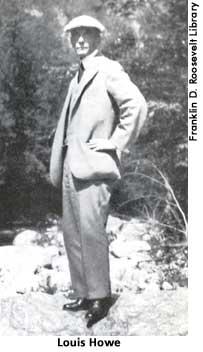Louis McHenry Howe (1871-1936)
Louis McHenry Howe was born in Indianapolis, Indiana, on January 14, 1871, to Edward Porter Howe, a Civil War veteran who worked as an insurance executive and small-time newspaper publisher, and Eliza Blake Ray. After watching their son battle a series of illnesses and accidents, the Howes thought Louis could not handle the roughness of public school and enrolled him instead in the Temple Grove Seminary for young women in Saratoga Springs, New York. Howe began his journalism career at seventeen when he joined the staff of his father's Democratic-leaning weekly, The Sun, and began freelancing for other regional papers, often scooping his rivals. When The Sun folded in 1900, he turned to freelancing full time and in 1906 the New York Herald hired him to assist in their coverage of the Albany legislature.
Eventually his interests moved from covering politics to politics itself. In 1906, Howe began handling political matters for Auburn, New York, Mayor Thomas Mott Osborne. Their collaboration was not smooth and Osborne fired Howe three years later. In 1911, Howe became enthralled with FDR's anti-Tammany insurgency within the state senate. When typhoid sidelined FDR in the midst of his 1912 re-election effort, ER asked Howe to manage FDR's campaign. Howe and FDR quickly became devoted to one another and Howe adopted FDR's ambitions as his own. When FDR became assistant secretary of the navy in 1913, Howe accompanied FDR to Washington and served as his chief of staff, deftly using the patronage positions FDR had at his disposal to weaken Tammany and shore up the FDR factions within the party. When the Democrats tapped FDR as their vice-presidential nominee, FDR then asked Howe to manage his 1920 campaign. Howe then tutored ER, as they rode the campaign train, becoming, according to Blanche Wiesen Cook, ER's confidant, mentor, and jolly chum.
Howe's dedication to both Roosevelts was fierce. When polio paralyzed FDR in 1921, Howe strove to boost FDR's spirits, preserve his political reputation, and support ER in her efforts to bolster FDR's independence and continue her own public commitments. In the process, he helped ER master public speaking and navigate the turf wars of New York politics. He helped keep FDR before the public by orchestrating FDR's statements on public issues, writing magazine articles published under FDR's byline, and coordinating FDR's appearance at the 1924 Democratic convention. Howe's efforts, coupled with ER's political network and FDR's incessant correspondence with Democrats across the nation, convinced New York Governor Alfred E. Smith (who was then the Democratic candidate for president) that FDR must be his successor in the New York statehouse. At first, Howe was reluctant for FDR to return to active politics (together they had planned to wait four more years). But quickly Howe was able to convenience voters that FDR's illness was not a reason to bar him from office.
FDR's election to the governorship in 1928 changed their relationship as Howe, while still FDR's closest advisor, now had to share the governor with other key members of his staff. During FDR's four years in Albany, Howe worked closely with both Roosevelts, promoting ER's literary work and assisting her political efforts while working unceasingly to secure the 1932 Democratic presidential nomination for FDR. The more successful Howe became in promoting FDR, the more advice FDR sought for other quarters, much of which challenged Howe's more traditional political views. Rivalries within FDR's inner circle developed and the asthmatic Howe's always frail health declined rapidly. Once FDR won the nomination, to Howe's great dismay, much of FDR's postconvention campaign would be managed by a team lead by Jim Farley.
Having mentored, pushed, and championed FDR for twenty years, FDR's victory meant almost as much to Howe as it did to FDR. FDR appointed Howe his personal secretary, a title that allowed Howe great latitude and few official duties, and Howe moved into the White House. Although his health quickly deteriorated, Howe continued to speak bluntly and frankly to FDR, refusing to let the aura of the presidency isolate him from the man whom he had supported for two decades. His advice to ER was just as honest and bold. He encouraged her to hold women-only press conferences, helped choreograph her media campaigns, and supported her efforts to find a way to address issues and shape policy. Howe especially championed the Civilian Conservation Corps, the Subsistence Homestead programs, and the New Deal's anti-crime initiative.
Howe entered the Bethesda Naval Hospital on August 21, 1935 and remained there until his death April 18, 1936. ER arranged a state funeral in the East Room of the White House for her friend, whom she would later describe as "one of the seven most important people" in her life.
Sources:
American National Biography. New York: Oxford University Press, 1999, 335-6.
Cook, Blanche Wiesen. Eleanor Roosevelt: Volume Two, 1933-1938. New York: Viking Press, 1999, 348-352.
Graham, Otis L., Jr. and Meghan Robinson Wander. Franklin D. Roosevelt His Life and Times. New York: DaCapo Press, 1985, 189-190.


